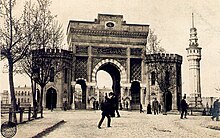Education in the Ottoman Empire
In the Ottoman Empire each, and every millet (religious group) established a schooling system serving its members.
[1] Education, therefore, was largely divided on ethnic and religious lines: few non-Muslims attended schools for Muslim students and vice versa.
[8] Lucy Garnett stated in the 1904 book Turkish Life in Town and Country that even though introductory reading and writing units had been recently introduced, "instruction given in [the schools] is chiefly of a religious character".
[2] The modern-style secondary schools, serving boys and preparing students for western-style secondary/higher education, were called Idadiyeh.
[15] Garnett stated that the Ottomans were adding more schools for working and middle class Turkish girls but that "equipment" was often not sufficient and there were still not enough of them.
[16] Several "foreign schools" (Frerler mektebleri) operated by religious clergy primarily served non-Muslims, although some Muslim students attended.
[17] Johann Strauss, author of "Language and power in the late Ottoman Empire," stated that "a common schooling system" for all religious and ethnic groups never occurred, partly because members of non-Muslim groups resisted learning Turkish, and not due to an inability to learn Turkish; the schools for non-Muslims focused on promotion of ethnic languages.
[2] Garnett described the schools for Christians and Jews as "organised upon European models", with donations supporting their operation and most of them being "well attended" and with "a high standard of education".
Johann Strauss stated that the Ottoman Empire established its university system later than Austria-Hungary and Russia had.
Strauss stated that it helped build the elite of Arab and Albanian areas within the Ottoman Empire and post-Ottoman countries.
The school had a significant number of Armenian and Greek faculty and students even though Ottoman Turkish was the educational medium.







